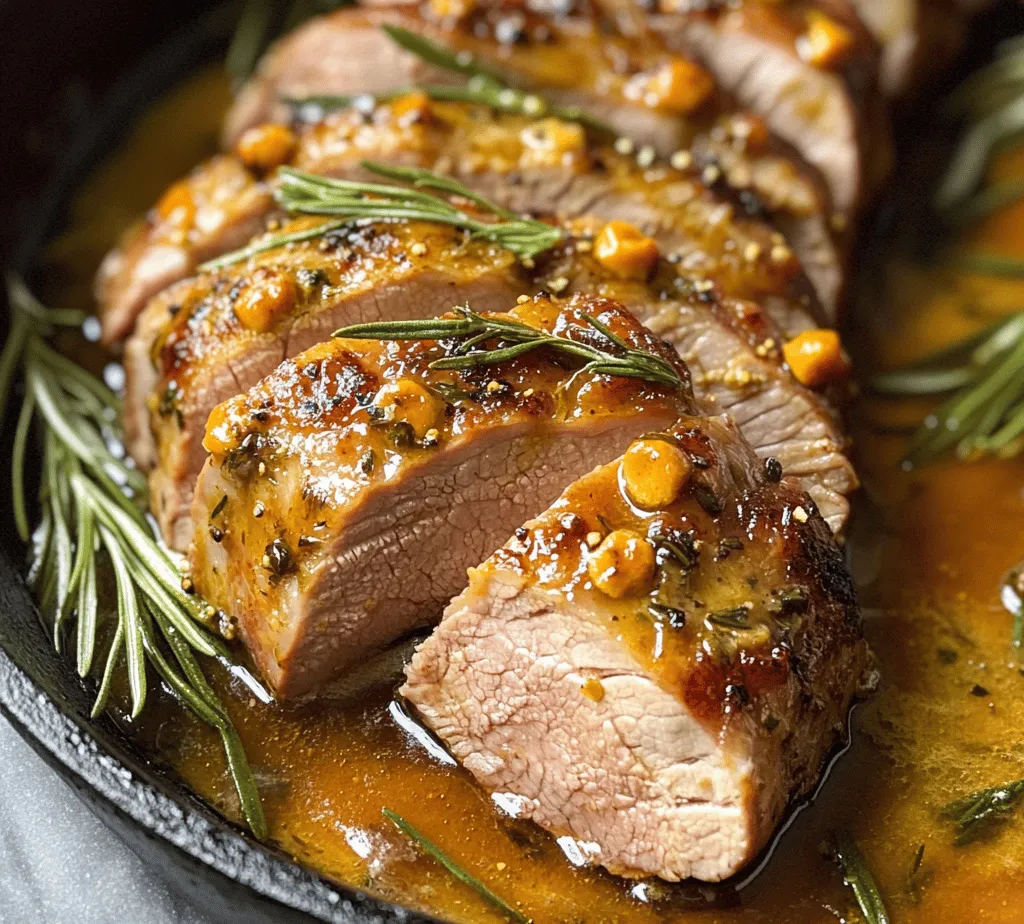Introduction
If you’re searching for a mouthwatering dish that combines convenience with flavor, look no further than honey mustard pork tenderloin. This delectable recipe captures the essence of sweet and savory, creating a symphony of flavors that delights the palate. The beauty of this dish lies not only in its appealing taste but also in its simplicity; it takes minimal preparation and can be cooked in under an hour, making it a perfect choice for both weeknight dinners and special occasions.
Pork tenderloin, when prepared correctly, is incredibly tender and juicy. The balance of flavors in this recipe—where the sweetness of honey meets the tanginess of mustard—elevates the dish to new heights. This harmony of sweet and savory is particularly important in pork dishes, as it helps to counteract any potential dryness, ensuring that each bite is succulent and flavorful.
Moreover, the health benefits of the ingredients make this dish even more appealing. Honey not only adds sweetness but also provides antioxidants, while mustard is known for its potential anti-inflammatory properties. Together, they create a marinade that not only enhances the flavor of the pork but also contributes to the overall nutritional profile of your meal.
Understanding the Ingredients
Pork tenderloin is a standout choice for a protein base in this recipe. This cut is renowned for its tenderness and mild flavor, making it an excellent blank canvas that absorbs marinades beautifully. Nutritionally, pork tenderloin is a lean cut of meat, providing high-quality protein with lower fat content compared to other pork cuts, such as pork belly or shoulder. It’s rich in essential vitamins and minerals, including B vitamins, zinc, and selenium, which are vital for energy metabolism and immune function.
Choosing tenderloin over other cuts comes down to texture and cooking time. Tenderloin is one of the most tender cuts of pork and cooks relatively quickly, which is ideal for busy home cooks. Unlike tougher cuts that require long, slow cooking methods to become tender, pork tenderloin can be roasted, grilled, or sautéed in a fraction of the time, making it a practical option for a weeknight meal.
Detailed Breakdown of Each Ingredient
1. Honey:
Honey is the star of this dish. Not only does it add a natural sweetness, but it also has a unique flavor profile that can vary depending on its floral source. Whether you choose clover, wildflower, or even Manuka honey, each type brings its own nuances to the dish. Health-wise, honey is rich in antioxidants and has been linked to various health benefits, including improved heart health and wound healing. It also contains trace amounts of vitamins and minerals, enhancing its appeal as a natural sweetener.
2. Dijon Mustard:
Dijon mustard is a key ingredient that adds depth and tang to the marinade. Its smooth texture and sharp flavor provide a perfect balance to the sweetness of honey. If you don’t have Dijon mustard on hand, whole grain mustard or yellow mustard can be used as alternatives, although they will impart slightly different flavors. Dijon mustard is also low in calories and fat, making it a great choice for flavor enhancement without adding too many extra calories.
3. Olive Oil:
Olive oil serves a dual purpose in this recipe: it helps to disperse the flavors of the marinade and keeps the pork moist during cooking. Rich in monounsaturated fats, olive oil is a heart-healthy option that can improve cholesterol levels and reduce inflammation. Extra virgin olive oil, in particular, is packed with antioxidants and has been linked to numerous health benefits.
4. Garlic:
Garlic not only adds a robust flavor but also boasts impressive nutritional value. It is known for its potential health benefits, including immune system support and cardiovascular health. Fresh garlic will provide a more intense flavor compared to dried garlic powder, making it the preferred choice for this recipe. The aromatic nature of garlic complements the sweetness of the honey and the acidity of the mustard, creating a well-rounded marinade.
5. Fresh vs. Dried Rosemary:
Rosemary is an aromatic herb that adds an earthy note to the dish. Fresh rosemary has a more vibrant flavor than dried, and its needles can infuse the marinade with a fragrant aroma. If you only have dried rosemary, be aware that it is more concentrated, so use about one-third of the amount called for fresh. Rosemary is also rich in antioxidants and has anti-inflammatory properties, adding another layer of health benefits to your meal.
6. Lemon Juice and Zest:
The addition of lemon juice and zest not only brightens the overall flavor but also helps to tenderize the pork. The acidity in lemon juice can break down proteins, leading to a more tender cut of meat. Furthermore, lemon zest adds a refreshing citrus aroma that complements the other ingredients beautifully.
7. Optional Soy Sauce:
While not a requirement in this recipe, soy sauce can be included to enhance the umami flavor, providing a savory depth to the marinade. It is particularly beneficial if you enjoy a slightly saltier profile. If you are concerned about sodium intake, consider using low-sodium soy sauce or tamari for a gluten-free option.
Marinade Essentials
Marinating is a crucial step in this recipe, as it allows the flavors to penetrate the pork tenderloin, ensuring that every bite is infused with the delicious honey mustard blend. The importance of marinating cannot be overstated; it not only enhances the flavor but also helps to tenderize the meat, resulting in a juicier, more enjoyable dish.
Step-by-Step Guide on Preparing the Marinade
1. Gather Your Ingredients: Start by measuring out the honey, Dijon mustard, olive oil, minced garlic, chopped rosemary, lemon juice, and optional soy sauce if you’re using it.
2. Mix the Marinade: In a mixing bowl, combine the honey, Dijon mustard, and olive oil. Whisk these ingredients together until they are well blended. The oil will help to keep the pork moist while cooking, while the honey and mustard create that signature flavor.
3. Add Aromatics: Next, stir in the minced garlic and chopped fresh rosemary. If you’re using lemon juice, add that now as well. The acidity from the lemon juice will help to tenderize the meat, while the garlic and rosemary add depth of flavor.
4. Adjust Consistency: If the marinade seems too thick, you can add a splash of water or more olive oil to achieve your desired consistency. The marinade should be pourable but thick enough to cling to the pork.
5. Taste and Adjust: Before you set your marinade aside, taste it. This is your chance to adjust the balance of flavors. If you want it sweeter, add more honey; if you prefer it tangier, a bit more mustard or lemon juice will do the trick.
6. Marinate the Pork: Once your marinade is ready, place the pork tenderloin in a resealable plastic bag or a shallow dish and pour the marinade over the top. Ensure that the pork is well-coated, then seal the bag or cover the dish. For optimal flavor, let the pork marinate in the refrigerator for at least 30 minutes, but if you have time, aim for 2-4 hours or even overnight for deeper flavor infusion.
By following these steps, you’ll create a marinade that not only enhances the natural flavors of the pork tenderloin but also provides a delicious, well-rounded dish that is sure to impress your family and friends. The balance of honey and mustard, combined with the aromatic herbs and spices, will transform your pork tenderloin into a culinary masterpiece that will leave everyone craving more. Stay tuned for the next part, where we will delve into the cooking process and tips for achieving the perfect honey mustard pork tenderloin.

How Marinating Times Affect Flavor and Texture
Marinating is a crucial step in preparing honey mustard pork tenderloin, as it significantly impacts both flavor and texture. The marinade, which typically consists of honey, mustard, olive oil, and various herbs and spices, penetrates the meat to infuse it with flavor. The longer you let the pork tenderloin marinate, the more pronounced the flavors will be.
However, it’s important to note that marinating for too long can lead to a mushy texture due to the acids in the marinade breaking down the proteins in the meat. A balance is essential.
Recommended Marinating Periods for Best Results
For optimal flavor and tenderness, marinate the pork tenderloin for at least 2 hours, but ideally between 4 to 6 hours. If you have the time, marinating overnight (up to 24 hours) in the refrigerator will yield the best results, allowing the flavors to deeply penetrate the meat. Always remember to turn the tenderloin occasionally to ensure even coverage of the marinade.
Cooking Techniques
Preheating the Oven: Importance in Cooking
Preheating your oven is a vital step when preparing honey mustard pork tenderloin. It ensures that the meat cooks evenly from the moment it’s placed inside, which is essential for achieving that perfect doneness and a beautifully browned exterior. A properly preheated oven helps to lock in moisture and flavor while preventing the meat from overcooking.
Searing vs. Baking: How These Techniques Enhance Flavor
Searing and baking are two cooking techniques that work harmoniously together to enhance the overall flavor profile of your pork tenderloin. Searing, which involves cooking the meat quickly over high heat, creates a caramelized crust through the Maillard reaction. This not only adds depth of flavor but also creates a visually appealing golden-brown exterior.
Baking, on the other hand, allows the tenderloin to cook evenly throughout, ensuring that it remains juicy and tender. By starting with a sear and finishing in the oven, you achieve a combination of both worlds: a flavorful crust and a succulent interior.
Explanation of the Maillard Reaction During Searing
The Maillard reaction is a complex chemical reaction between amino acids and reducing sugars that occurs when food is cooked at high temperatures. This reaction is responsible for the rich, savory flavors and appealing brown color in seared meats. When you sear your honey mustard pork tenderloin before baking, you are initiating this reaction, which significantly enhances the taste of the dish. It’s one of the secrets to achieving restaurant-quality results at home.
Benefits of Oven Cooking for Tenderness
Cooking pork tenderloin in the oven provides several benefits, particularly regarding tenderness. The gentle, even heat of an oven helps to break down connective tissues while allowing the meat to cook slowly. This method reduces the risk of drying out the pork, resulting in a juicy and tender final product. By baking at a moderate temperature (around 375°F or 190°C), you allow the tenderloin to cook through without losing moisture.
Understanding Doneness: Using a Meat Thermometer
To ensure your honey mustard pork tenderloin is cooked to perfection, using a meat thermometer is highly recommended. This tool provides an accurate reading of the internal temperature, allowing you to avoid the guesswork. The USDA recommends cooking pork to an internal temperature of at least 145°F (63°C). At this temperature, the pork will be juicy and safe to eat.
Safe Internal Temperatures for Pork
When measuring the internal temperature, insert the meat thermometer into the thickest part of the tenderloin, avoiding contact with bone or fat. Once the thermometer reads 145°F, remove the pork from the oven and let it rest. The internal temperature will continue to rise slightly during resting, ensuring that it reaches optimal doneness without overcooking.
Serving Suggestions
How to Properly Slice Pork Tenderloin for Presentation
Once your honey mustard pork tenderloin has rested for about 5-10 minutes, it’s time to slice and serve. To achieve beautiful, even slices, use a sharp knife and cut against the grain of the meat. This technique shortens the muscle fibers, resulting in more tender bites. Aim for slices that are approximately ½ inch thick for an appealing presentation.
Ideas for Side Dishes That Complement Honey Mustard Pork
Honey mustard pork tenderloin pairs wonderfully with a variety of side dishes that can enhance its flavor:
- Roasted Vegetables: Carrots, Brussels sprouts, and sweet potatoes roasted with olive oil and seasonings provide a colorful and nutritious complement.
- Garlic Mashed Potatoes: Creamy mashed potatoes infused with garlic create a comforting pairing that balances the sweetness of the pork.
- Grain Salads: Quinoa or farro salads mixed with fresh herbs, cucumbers, and a light vinaigrette can provide a refreshing counterpoint to the rich flavors of the pork.
Suggested Salads, Vegetables, and Grain Pairings
To round out your meal, consider these additional pairings:
- Salads: A mixed greens salad with a citrus vinaigrette can brighten up the plate. Add sliced almonds or goat cheese for extra flavor and texture.
- Vegetables: Steamed green beans or sautéed asparagus drizzled with lemon juice will add a fresh element to your meal.
- Grains: A wild rice pilaf with cranberries and nuts can introduce a delightful chewiness that complements the tender pork.
Garnishing Tips to Enhance Visual Appeal
Presentation is key when serving honey mustard pork tenderloin. Consider these garnishing tips for an impressive plate:
- Fresh Herbs: Sprinkle fresh parsley or thyme over the sliced pork for a pop of color.
- Sliced Citrus: Arrange thin slices of lemon or orange around the plate to enhance visual appeal and add a touch of brightness.
- Drizzle of Sauce: A light drizzle of the reserved honey mustard marinade (cooked to ensure safety) over the sliced pork can enhance flavor and make the dish visually appealing.
Nutritional Information
When preparing honey mustard pork tenderloin, you can enjoy a delicious meal that also provides essential nutrients. Here’s a breakdown of the nutritional content per serving (based on a 4-ounce portion of cooked pork):
- Calories: Approximately 220 calories
- Protein: 28 grams
- Total Fat: 10 grams
- Saturated Fat: 2 grams
- Carbohydrates: 6 grams
- Fiber: 0 grams
- Sugars: 4 grams
This dish is high in protein, making it a great choice for those looking to maintain muscle mass or follow a high-protein diet. Additionally, the healthy fats from olive oil contribute to heart health.
Conclusion
Honey mustard pork tenderloin is a versatile dish that combines sweet and tangy flavors with the tenderness of pork. The marinating process enhances the taste, while the cooking techniques ensure a perfect balance of flavor and texture.
We encourage you to try this recipe at home and experience its delightful flavors and versatility. The combination of honey and mustard not only elevates this dish but can also be adapted into other recipes, making it a staple in your culinary repertoire. Whether served for a family dinner or a special occasion, honey mustard pork tenderloin will impress and satisfy your guests. Enjoy the journey of creating this dish, and savor every bite!


